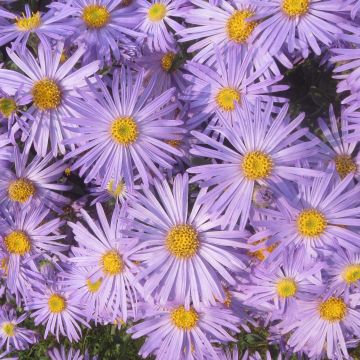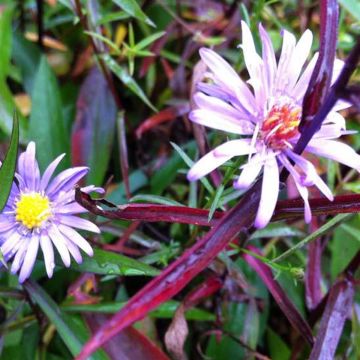

Aster novi-belgii Sarah Ballard
Aster novi-belgii Sarah Ballard
Aster novi-belgii Sarah Ballard
New York Aster, Michaelmas Daisy
This item cannot be shipped to the selected country
Delivery charge from €5.90
More information
Schedule delivery date,
and select date in basket
This plant carries a 12 months recovery warranty
More information
We guarantee the quality of our plants for a full growing cycle, and will replace at our expense any plant that fails to recover under normal climatic and planting conditions.
From €5.90 for pickup delivery and €6.90 for home delivery
Express home delivery from €8.90.

Does this plant fit my garden?
Set up your Plantfit profile →
Description
Aster novi-belgii 'Sarah Ballard' is a tall perennial, which offers beautiful and numerous blue-mauve star-shaped flowers with particularly slender petals from late summer to autumn. Robust, romantic, and charming in its simplicity, it is a reliable choice to adorn your sunny or lightly shaded, moist flower beds at the end of the season.
Aster 'Sarah Ballard' belongs to the large botanical family of Asteraceae, which includes many well-known ornamentals such as daisies, rudbeckias, echinaceas... New Belgium, which gives it its name, is a region located on the northeast coast of the United States, also known as New Netherland or New Holland. This aster grows in American prairies, and has spread widely worldwide following its introduction in horticulture in the form of countless varieties of varying heights. It should be noted that botanists now classify this species in the new genus Symphyotrichum, which includes New World asters.
Aster novi-belgii produces tall, upright stems, bearing numerous star-shaped flowers between August and October (or even November). Each "flower" is actually a cluster of many flowers: the central, golden ones are "tubular" and fertile. The peripheral, "ligulate," ones are sterile and attract pollinating insects. The deciduous foliage, measuring between 5 and 10 cm (2 and 4in), is lanceolate, tender green, and smooth (which distinguishes it from the New England aster, another North American species with rough leaves).
The 'Sarah Ballard' variety is distinguished by an upright habit reaching 80 cm (32in) to 1 metre (3 feet) in height, with a minimum diameter of 50 cm (20in) due to its rhizomes. In this variety, the "petals" are a beautiful bluish mauve, and their tips are sharper than in most other New Belgium asters. The centres of the heads are golden, then turn reddish-brown. The feathery seeds are also attractive and retain a sculptural aspect for a good part of the winter.
The 'Sarah Ballard' aster is a reliable and hardy plant that appreciates moist, fairly fertile soil. Prolonged periods of drought often lead to the appearance of powdery mildew, a fungal disease that manifests as grey or white spots on the leaves. This disease is not harmful to the plant's health but is not very attractive. A sunny location is preferred, or light shade. When exposed to too dense shade, the plant becomes limp, and blooms less. Also avoid planting this aster in a very windy area that would make the stems bend. Each plant spreads through its rhizomes, eventually forming a beautiful clump. After a few years, it is advisable (and easy) to divide the clump to prevent the centre from hollowing out. If the plant likes its location, it may self-seed here and there.
The 'Sarah Ballard' aster is perfect for gardeners looking to enliven autumn flower beds, and it will find a place alongside other late-interest plants such as Japanese anemone 'Splendens' in partial shade, Ceratostigma plumbaginoides in full sun, and grasses like Andropogon 'Prairie Sommer' and panic 'Blue Darkness'.
Report an error about the product description
Flowering
Foliage
Plant habit
Botanical data
Aster
novi-belgii
Sarah Ballard
Asteraceae
New York Aster, Michaelmas Daisy
Cultivar or hybrid
Other Asters
Planting and care
Plant Aster 'Sarah Ballard' in autumn or spring in a normal, rich, and well-worked soil that retains moisture. It appreciates a sunny exposure but can tolerate partial shade where it will have a slightly looser habit. Avoid strong winds that could flatten the clumps. Once established, it should not be moved as it does not tolerate this well. In a flowerbed, maintain a spacing of at least 50 cm (20in) between plants. Mulch the soil from June onwards and water in heatwaves. Aster novi-belgii is susceptible to powdery mildew, which appears as a white powdery coating on the leaves. Spray preventively with Bordeaux mixture or a copper-based product. Divide the clumps every three years to keep them floriferous and more resistant to disease. Do not replant the divisions back in the same spot and provide them with rich soil.
Planting period
Intended location
Care
-
, onOrder confirmed
Reply from on Promesse de fleurs
Haven't found what you were looking for?
Hardiness is the lowest winter temperature a plant can endure without suffering serious damage or even dying. However, hardiness is affected by location (a sheltered area, such as a patio), protection (winter cover) and soil type (hardiness is improved by well-drained soil).

Photo Sharing Terms & Conditions
In order to encourage gardeners to interact and share their experiences, Promesse de fleurs offers various media enabling content to be uploaded onto its Site - in particular via the ‘Photo sharing’ module.
The User agrees to refrain from:
- Posting any content that is illegal, prejudicial, insulting, racist, inciteful to hatred, revisionist, contrary to public decency, that infringes on privacy or on the privacy rights of third parties, in particular the publicity rights of persons and goods, intellectual property rights, or the right to privacy.
- Submitting content on behalf of a third party;
- Impersonate the identity of a third party and/or publish any personal information about a third party;
In general, the User undertakes to refrain from any unethical behaviour.
All Content (in particular text, comments, files, images, photos, videos, creative works, etc.), which may be subject to property or intellectual property rights, image or other private rights, shall remain the property of the User, subject to the limited rights granted by the terms of the licence granted by Promesse de fleurs as stated below. Users are at liberty to publish or not to publish such Content on the Site, notably via the ‘Photo Sharing’ facility, and accept that this Content shall be made public and freely accessible, notably on the Internet.
Users further acknowledge, undertake to have ,and guarantee that they hold all necessary rights and permissions to publish such material on the Site, in particular with regard to the legislation in force pertaining to any privacy, property, intellectual property, image, or contractual rights, or rights of any other nature. By publishing such Content on the Site, Users acknowledge accepting full liability as publishers of the Content within the meaning of the law, and grant Promesse de fleurs, free of charge, an inclusive, worldwide licence for the said Content for the entire duration of its publication, including all reproduction, representation, up/downloading, displaying, performing, transmission, and storage rights.
Users also grant permission for their name to be linked to the Content and accept that this link may not always be made available.
By engaging in posting material, Users consent to their Content becoming automatically accessible on the Internet, in particular on other sites and/or blogs and/or web pages of the Promesse de fleurs site, including in particular social pages and the Promesse de fleurs catalogue.
Users may secure the removal of entrusted content free of charge by issuing a simple request via our contact form.
The flowering period indicated on our website applies to countries and regions located in USDA zone 8 (France, the United Kingdom, Ireland, the Netherlands, etc.)
It will vary according to where you live:
- In zones 9 to 10 (Italy, Spain, Greece, etc.), flowering will occur about 2 to 4 weeks earlier.
- In zones 6 to 7 (Germany, Poland, Slovenia, and lower mountainous regions), flowering will be delayed by 2 to 3 weeks.
- In zone 5 (Central Europe, Scandinavia), blooming will be delayed by 3 to 5 weeks.
In temperate climates, pruning of spring-flowering shrubs (forsythia, spireas, etc.) should be done just after flowering.
Pruning of summer-flowering shrubs (Indian Lilac, Perovskia, etc.) can be done in winter or spring.
In cold regions as well as with frost-sensitive plants, avoid pruning too early when severe frosts may still occur.
The planting period indicated on our website applies to countries and regions located in USDA zone 8 (France, United Kingdom, Ireland, Netherlands).
It will vary according to where you live:
- In Mediterranean zones (Marseille, Madrid, Milan, etc.), autumn and winter are the best planting periods.
- In continental zones (Strasbourg, Munich, Vienna, etc.), delay planting by 2 to 3 weeks in spring and bring it forward by 2 to 4 weeks in autumn.
- In mountainous regions (the Alps, Pyrenees, Carpathians, etc.), it is best to plant in late spring (May-June) or late summer (August-September).
The harvesting period indicated on our website applies to countries and regions in USDA zone 8 (France, England, Ireland, the Netherlands).
In colder areas (Scandinavia, Poland, Austria...) fruit and vegetable harvests are likely to be delayed by 3-4 weeks.
In warmer areas (Italy, Spain, Greece, etc.), harvesting will probably take place earlier, depending on weather conditions.
The sowing periods indicated on our website apply to countries and regions within USDA Zone 8 (France, UK, Ireland, Netherlands).
In colder areas (Scandinavia, Poland, Austria...), delay any outdoor sowing by 3-4 weeks, or sow under glass.
In warmer climes (Italy, Spain, Greece, etc.), bring outdoor sowing forward by a few weeks.














































